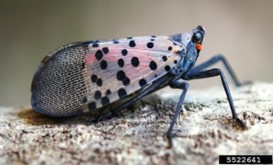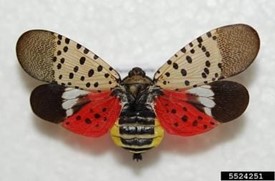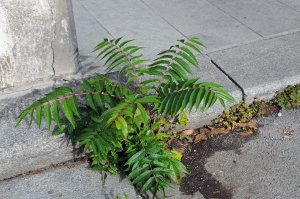Michigan Invasive Species Grant: Spotted Lanternfly and Tree of Heaven
March 6, 2024
By Ali Groulx, Park Interpreter and Katie Carlisle, Interim Chief of Natural Resources

In the spring of 2023, the Huron-Clinton Metroparks was awarded the Michigan Invasive Species grant to survey for Lycorma delicatula, widely known as the spotted lanternfly (SLF). The SLF is an invertebrate species from Asia that was first detected in Pennsylvania in 2014. They are a member of the leaf hopper and tree hopper family. Our native leafhoppers, like the candy-striped leafhopper, are relatively harmless to the plants they call home. Michigan’s native plants and insects tend to work together because they evolved together. However, the non-native SLF damages native plants such as grapevines and trees. They serve a purpose in their native ecosystems in Vietnam, India, and China, but here, they cause havoc. There is a slight complication, though – the SLF is not alone. They have been joined by their favorite home base, the tree of heaven (Ailanthus altissima), also native to Asia. This tree is an aggressive species that clones itself at any sense of danger, so knowing of its presence is important. The SLF life cycle depends on this tree because they evolved together; the SLF prefers to lay their eggs on the bark, and tree of heaven is their favorite food. These two non-native species have found a niche in Michigan, with favorable climates and little competition. Many non-native pests have found their homes in Michigan over the past one hundred years; from hitchhiking on ships and boats, hiding in building materials, or escaping from gardens. There are many ways non-native species become prevalent in our spaces, but with a keen eye and consistent monitoring, non-native species can be recognized and controlled long before they become a problem.
 In 2022, a new population of SLF was found in Pontiac, MI. Four regional Metroparks are located within a 20-mile range of this site: Kensington, Indian Springs, Stony Creek, and Wolcott Mill. Together, these four parks contain over 14,000 acres that include high-quality natural areas of grasslands, woodlands, wetlands, and lakes. As a part of the grant with the help of a contractor, the Metroparks are surveying the woodlands in these parks for possible infestations of tree of heaven and SLF. A competitive bidding process helped select Superior Invasive Plant Solutions for help completing visual surveys. These surveys start around known tree of heaven populations in the spring, summer, and fall. The three-year grant project will run until 2025.
In 2022, a new population of SLF was found in Pontiac, MI. Four regional Metroparks are located within a 20-mile range of this site: Kensington, Indian Springs, Stony Creek, and Wolcott Mill. Together, these four parks contain over 14,000 acres that include high-quality natural areas of grasslands, woodlands, wetlands, and lakes. As a part of the grant with the help of a contractor, the Metroparks are surveying the woodlands in these parks for possible infestations of tree of heaven and SLF. A competitive bidding process helped select Superior Invasive Plant Solutions for help completing visual surveys. These surveys start around known tree of heaven populations in the spring, summer, and fall. The three-year grant project will run until 2025.

Since the Michigan Invasive Species Grant project was started, roughly 1,420 acres of land have been surveyed so far. Kensington saw 527 acres surveyed, Stoney Creek 376 acres, Indian Springs 276 acres, and Wolcott Mill 240 acres. On this surveyed land, there were 9 total new tree of heaven populations detected across these parks. Because of the Michigan Invasive Species grant, these newly discovered tree of heaven populations are now on the radar of our Natural Area Crew for management. Throughout the summer, circle traps will be placed and observed on select trees by Superior Invasive Plant Solutions to monitor for the presence of SLF. Circle traps capture the young insects as they crawl up the tree and is an effective way to reduce SLF populations without much impact on other plants or animals. The best time for surveying is when the insects are in their adult form, typically starting in July when they begin to hang out regularly on their host trees. Ecosystem management like this allows us to maintain and restore Michigan’s natural habitats for vegetation, wildlife, and humans.
Early detection and rapid response (EDRR) is a common approach for new invasive species like the spotted lanternfly. The sooner they are detected and responded to, the higher the chances are of controlling the spread of the species. This is especially important in woodlands like the ones located in our Metroparks and local areas. As you enjoy the woods around you in southeast Michigan, keep an eye out for the spotted lanternfly. If you think you have found one, snap a photo and send it in to our Natural Resources Department with the location, or report it using the MISIN app. Together, we can protect our native plants and animals by preventing the spread of invasive species that find their haven here. The more people keeping a watchful eye, the more effectively we can preserve our beautiful, native habitats and wildlife for many generations to come.
